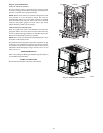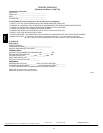
25
Theminimum maintenance requirements for thisequipment areas
follows:
1. Inspect air filter(s) each month. Clean or replace when
necessary.
2. Inspect indoor coil, drain pan, and condensate drain each
cooling season for cleanliness. Clean when necessary.
3. Inspectblowermotorand wheelforcleanlinesseach cooling
season. Clean when necessary .
4. Check electrical connections for tightness and controls for
proper operation each cooling season. Service when
necessary.
Step 1—Air Filter
IMPORTANT: Never operate the unit without a suitable air filter
inthereturn--airductsystem.Alwaysreplacethefilterwiththesame
dimensional size and type as originally installed. See Table 1 for
recommended filter sizes.
Inspect air filter(s) at least once each month a nd replace
(throwaway--type) or clean (cleanable--type) at least twice during
each cooling season and twice during the heating season, or
whenever the filter becomes clogged with dust and lint.
Step 2—Indoor Blower and Motor
NOTE: All motors are pre--lubricated. Do not attempt to lubricate
these motors.
Forlongerlife,operatingeconomy,andcontinuingefficiency,clean
accumulated dirt and grease from the blower wheel and motor
annually.
ELECTRICAL SHOCK HAZARD
Failure to follow this warning could result in personal injury
or death.
Disconnectand t agelectricalpowertotheunitbeforecleaning
and lubricating theblower motor and wheel.
!
WARNING
Step 3—Outdoor Coil, Indoor Coil, and Condensate
Drain Pan
Inspect the condenser coil, evaporator coil, and condensate drain
pan at least once each year.
The coils are easily cleaned when dry; therefore, inspect and clean
the coils either before or after each cooling season. Remove all
obstructions, including weeds and shrubs, that interfere with the
airflow through the condenser coil. Straighten bent fins with a fin
comb. If coated with dirt or lint, clean the coils with a vacuum
cleaner, using the soft brush attachment. Be careful not to bend the
fins.Ifcoatedwith oilorgrease,cleanthecoilswithamilddetergent
andwatersolution.Rinsecoilswithclearwater ,usingagardenhose.
Be careful not to splash water on motors, insulation, wiring, or air
filter(s). For best results, spray condenser coil fins from inside to
outsidetheunit.On unitswithan outerand innercondensercoil,be
sure to clean between the coils. Be sure to flush all dirt and debris
from the unit base.
Inspectthedrainpanandcondensatedrain linewheninspectingthe
coils. Clean the drain pan and condensate drain by removing all
foreign matter from the pan. Flush the pan and drain trough with
clearwater.Do not splash wateron the insulation, motor, wiring, or
airfilter(s). Ifthedraintrough isrestricted,clearitwith a“plumbers
snake” or similar probe device.
Step 4—Outdoor Fan
UNIT OPERATION HAZARD
Failure to follow this caution may result in damage to unit
components.
Keep the condenser fan free from all obstructions to ensure
proper cooling operation. Never place articles on top of the
unit.
CAUTION
!
1. Remove 6 screws holding outdoor grille and motor to top
cover.
2. Turn motor/grille assembly upside down on top cover to
expose fan blade.
3. Inspect the fan blades for cracks or bends.
4. If fan needsto be removed, loosensetscrew and s lide fan off
motor shaft.
5. When replacing fan blade, position blade so that the hub is
1/8 in.away from the motorend (1/8 in. ofmotor shaft will
be visible) (See Fig. 24).
6. Ensurethatsetscrew engagestheflatareaonthemotorshaft
when tightening.
7. Replace grille.
Infinity Top
A06035
UNIT SIZE
“A” DIMENSION
Infinity
024 25
030 25
036 24
042 24
048 24
060 19
Fig. 24 -- Fan Blade Clearance
Step 5—Electrical Controls and Wiring
Inspect and check the electrical controls and wiring annually. Be
sure to turn off the electrical power to the unit.
Remove accesspanel tolocateall theelectrical controls and wiring.
Check all electrical connections for tightness. Tighten all screw
connections. If any smoky or burned connections are noticed,
disassembletheconnection,clean alltheparts,re--stripthewireend
and reassemble the connection properly and securely.
After inspecting the electrical controls and wiring, replace all the
panels. Start the unit, and observe at least one complete cooling
cycle to ensure proper operation. If discrepancies are observed in
operating cycle, or if a suspected malfunction has occurred, check
each electrical component with the proper electrical
instrumentation. Refer to the unit wiring label when making these
checks.
50CR


















